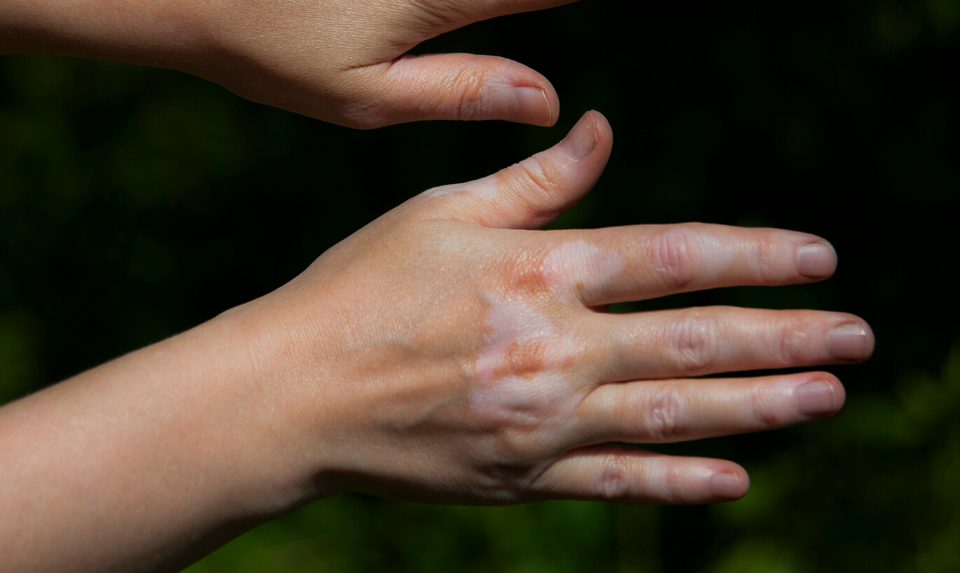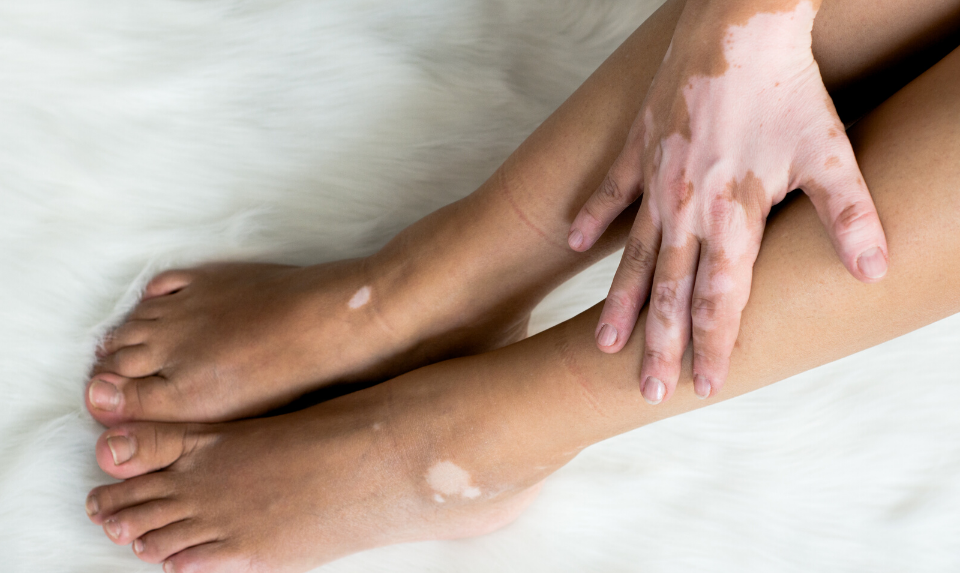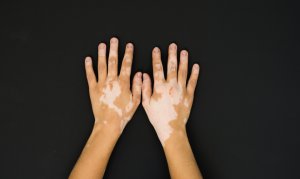Whether fair, dark, or any shade in between, most kids have skin that is normally the same color all over their body. But this isn’t the case for vitiligo in kids.

Vitiligo is a loss of skin pigment, or color, that cause white spots or patches to emerge on the skin. No one knows precisely why this happens, but we do know it affects individuals of both sexes and every race. In the United States alone, an approximate 1 to 2 million individuals have the condition, and more than half of the individuals are kids and teens.
The good news is that vitiligo — upsetting as it can be individuals who are living with it — isn’t medically dangerous. It’s not a form of skin cancer, it’s not a disease like MRSA, and it’s absolutely not infectious. Actually, most kids who have it are every bit as healthy as everybody else.
About Vitiligo in Kids
Vitiligo (vih-tih-LY-go) is a skin disorder that affects the melanocytes, cells deep within the skin whose function is to create melanin. Melanin is the pigment that gives skin its color and helps care for it from the sun.
Our skin color is determined not by how much melanocytes we have but rather by how active they are. Dark-skinned people have cells that obviously create a lot of melanin, while light-skinned people create much less.
Occasionally, though, skin cells unexpectedly stop producing melanin. Originally, this might cause a spot, called a macule, whose color is much lighter than the skin around it. But in time these light patches might spread and grow to cover a larger portion of the body. Occasionally the spread happens rapidly, and then remains steady for a number of years; other times it occurs gradually, over a longer period of time.
Dermatologists label the category of vitiligo in kids according to the quantity and position of the patches:
- Focal vitiligo happens when there are just a few spots in a particular area
- Generalized vitiligo is associated with a lot of spots all over the body that tend to be regular (they affect the right and left sides of the body like a mirror image). This is the most frequent form of the state.
- Segmental vitiligo is characterized by spots merely on one side of the body and frequently nowhere else. This type of vitiligo is relatively rare.
Even though vitiligo can appear anywhere on the body, it’s more probable to happen in:
- Areas those are bare to the sun, for instance the face or hands
- Skin that has folds, such as the elbows, knees, or groin
- Skin around orifices (body openings), such as the eyes, nostrils, belly button, and genital area
Though kids of every race are affected evenly, spots tend to be more noticeable on those with darker skin.
Sometimes vitiligo in kids include other symptoms, such as early graying of the hair or a loss of pigment on the lips; since pigment cells begin in these places as well.
Causes of Vitiligo in Kids
Theories differ on what causes vitiligo in kids. Some specialist thinks it is an autoimmune disorder (in which the immune system mistakenly attacks healthy melanocytes). Others think it is a hereditary condition, since over 30% of affected kids have a relative who also has it.
What is known is that the risk of developing vitiligo amplifies in kids with a family or personal history of thyroid disease, diabetes, and certain situations like alopecia (an autoimmune disease that causes hair loss). And vitiligo is never communicable — kids can’t “catch” it from somebody else.
Diagnosis
A dermatologist generally can create a diagnosis of vitiligo just by looking for the telltale white patches on the skin. On kids with extremely fair skin, a particular tool called a Woods lamp can be used. This lamp uses ultraviolet light in a dark room to light up areas of affected skin that would otherwise be difficult to see with the naked eye.
The consultant will also raise lots of questions about your child’s medical history, as well as whether somebody in the family has had skin conditions or autoimmune trouble in the past; whether your child just had a rash or sunburn; or whether he or she has had any other illnesses or been under stress. A blood test can be done to check for thyroid issues and diabetes, as these can increase the risk of vitiligo in kids.
Very seldom, the doctor can do a biopsy. A biopsy lets the doctor ensure for pigment cells in the skin. If the biopsy proves there are no pigment cells, this might verify a case of vitiligo.
Treatment
There is no “cure” for vitiligo. A number of patches will clear up without treatment. For those that don’t, treatments maybe able to help to level out the skin tone. You can try some at home; others need treatment by a doctor. Just keep in mind that results can be different — what works for one person may possibly work for another, and no treatment is likely to be 100% successful at making the spots vanish.
Here are ways to help if your child has vitiligo:
Sunscreen. One of the most vital things your child can do is wear sunscreen daily to protect against skin cancer. And since vitiligo spots can’t tan (they have no melanin), they might burn and scar. Having a tan on the rest of the body will only emphasize white patches even more, especially if a child has light skin.
Cosmetics. Other kinds of over-the-counter concealers are accessible. Ask your doctor for suggestion and try a variety of brands until you find the one that works well for your child.
Corticosteroid creams. Corticosteroids are a kind of medicine which, when applied to white patches very early in the sickness, may aid to “repigment” the skin. They lessen the swelling that causes a loss of pigment so that pigmented cells can come back to the skin. Some non-steroidal creams also create a similar effect.
Photochemotherapy with ultraviolet A (also known as PUVA). PUVA has two steps: first, a medication called psoralen is also applied to the white patches of skin or taken orally; after that, the skin is exposed to ultraviolet light, sometimes from the sun but frequently from a false source, like a UVA lamp. This turns the affected skin pink, which eventually tends to fade to a more normal (often slightly darker) color. There are side effects, which may contain severe sunburn and skin blistering. Other side effects can be more serious, so talk to your doctor regarding the risks involved.
Narrow-band ultraviolet B (UVB) therapy. This action is more widely used than PUVA. It’s similar to PUVA, excluding the ultraviolet light used is UVB in its place of UVA. As well, no psoralen is necessary beforehand, which get rid of some of the side effects.
Researchers are also looking into a new procedure called a melanocyte transplant. It works by removing a sample of usually pigmented skin and using it to grow new melanocytes in the lab. These can then be transplanted back to the depigmented skin to return some of the missing color.
When deciding which, if any, treatment to try, be wary of quick-fix “miracle” remedies you might see advertised. If it seems too good to be true, it possibly is. Constantly work with your child’s doctor to help you choose what’s best for your son or daughter.
Dealing With the Emotional Impact

If your child has vitiligo, you know that even though it isn’t unsafe to his or her physical health, it can still be a big deal. Any situation that makes kids look different from their peers can be psychologically tough, especially during the preteen and teen years when everyone’s trying so tough to fit in.
Some kids are unsurprisingly more resilient and do just fine against these challenges. But others require a bit more help. As a parent you can do lots to arm your child with assurance and self-esteem. Here are a few tips:
Don’t focus on the vitiligo or put strain on your child to cover it up. He or she needs to know your love and acceptance are unconditional.
Remind your child of all the things at which he or she excels — and how they have nothing to do with skin color.
Teach your child to be comfortable explaining what vitiligo is — and isn’t — to other kids. Once the mystery is taken away, most kids will discontinue staring and asking questions.
Encourage your child to say yes to play dates, pool parties, trips, and any other experiences he or she might be tempted to pass on because of the vitiligo.
Urge your son or daughter to volunteer or get concerned in the community. Giving back makes kids feel powerful.
Finally, get emotional support if your child needs it — especially if you see any signs of withdrawal, depression, or anxiety. Counselors, therapists, and vitiligo support groups be able to help.
I have been a family dentist in Phoenix, Arizona for over two decades. Arizona is my home, and I would never want to leave here for the world. I’m happily married to the dazzling Karen with two bustling boys.
I love the Bee Gees, so I just had to pick up this domain! On this blog, I will be offering the best of my wisdom to you about dentistry and the benefits of quality family dental care.
